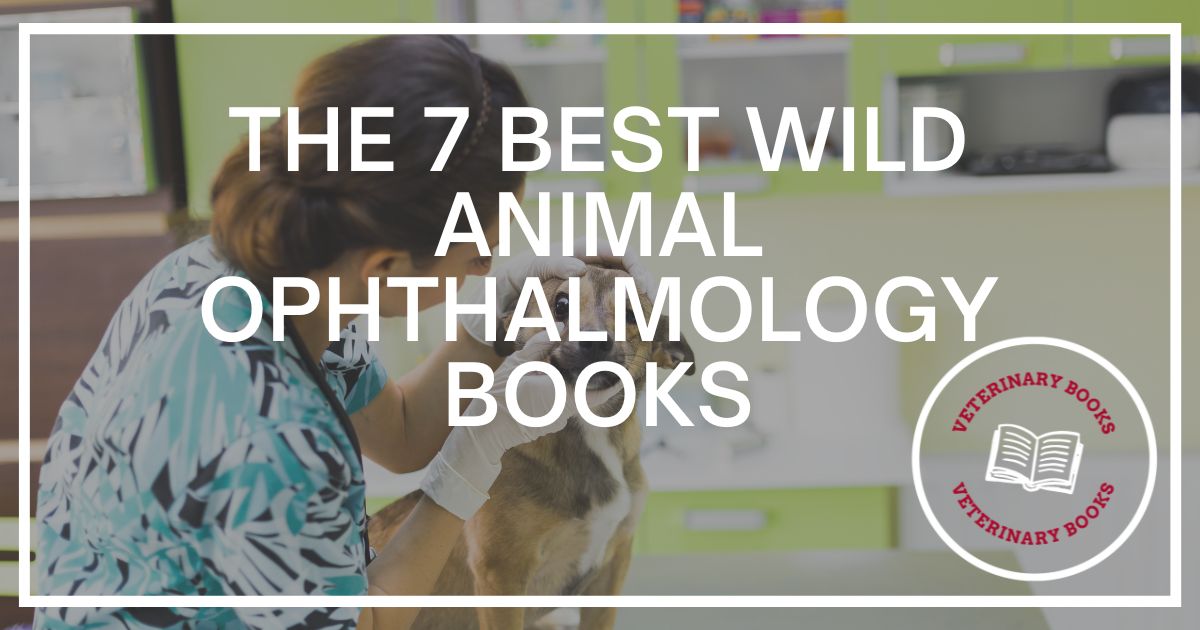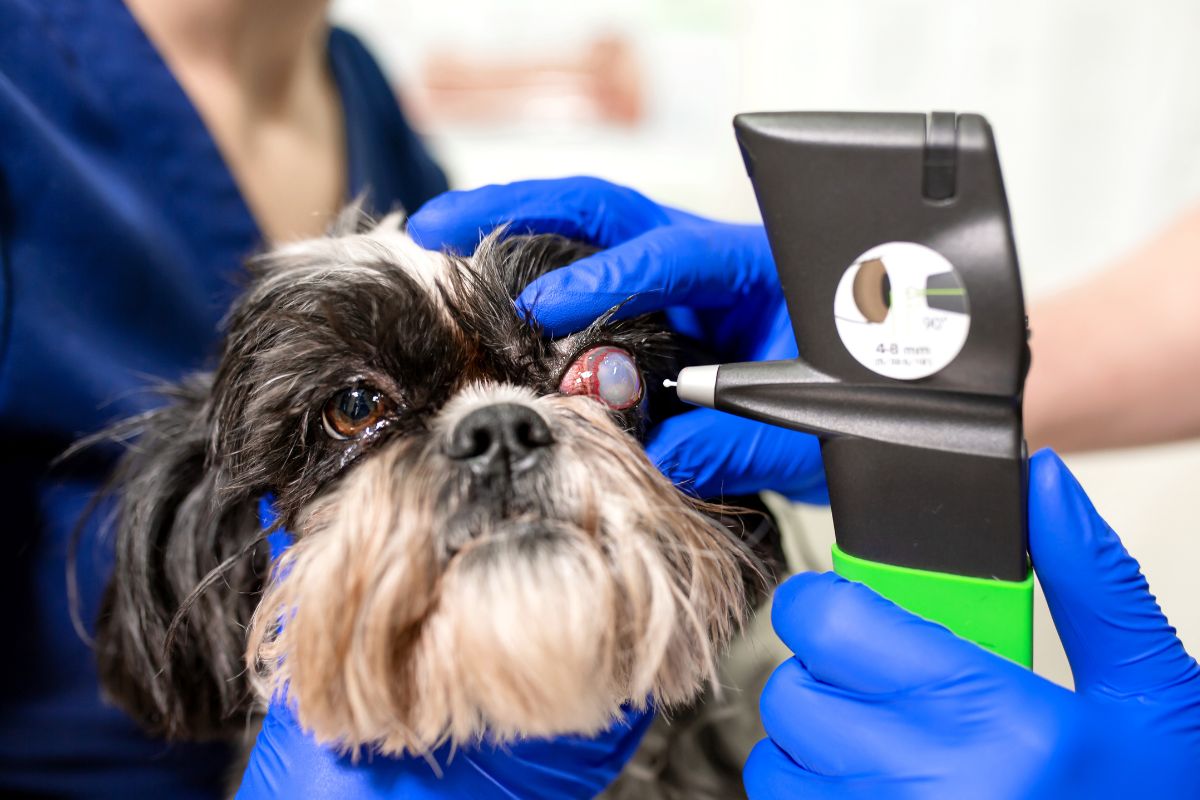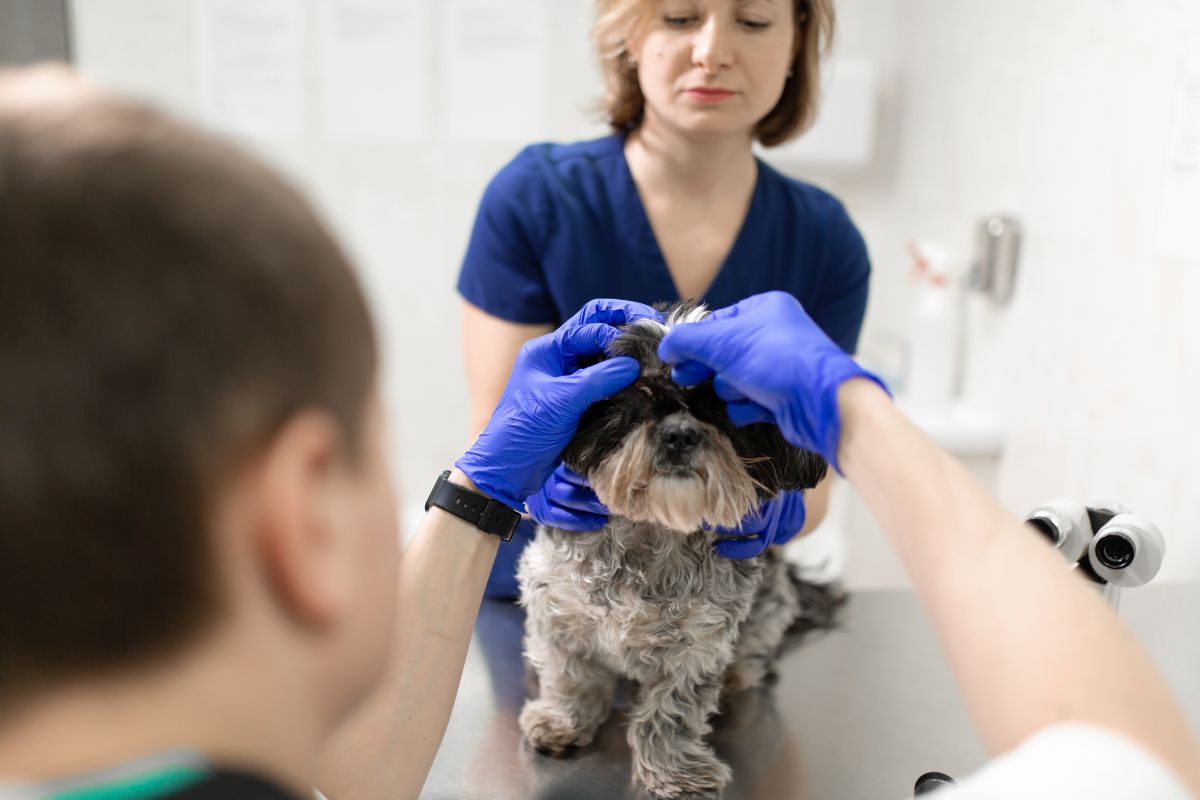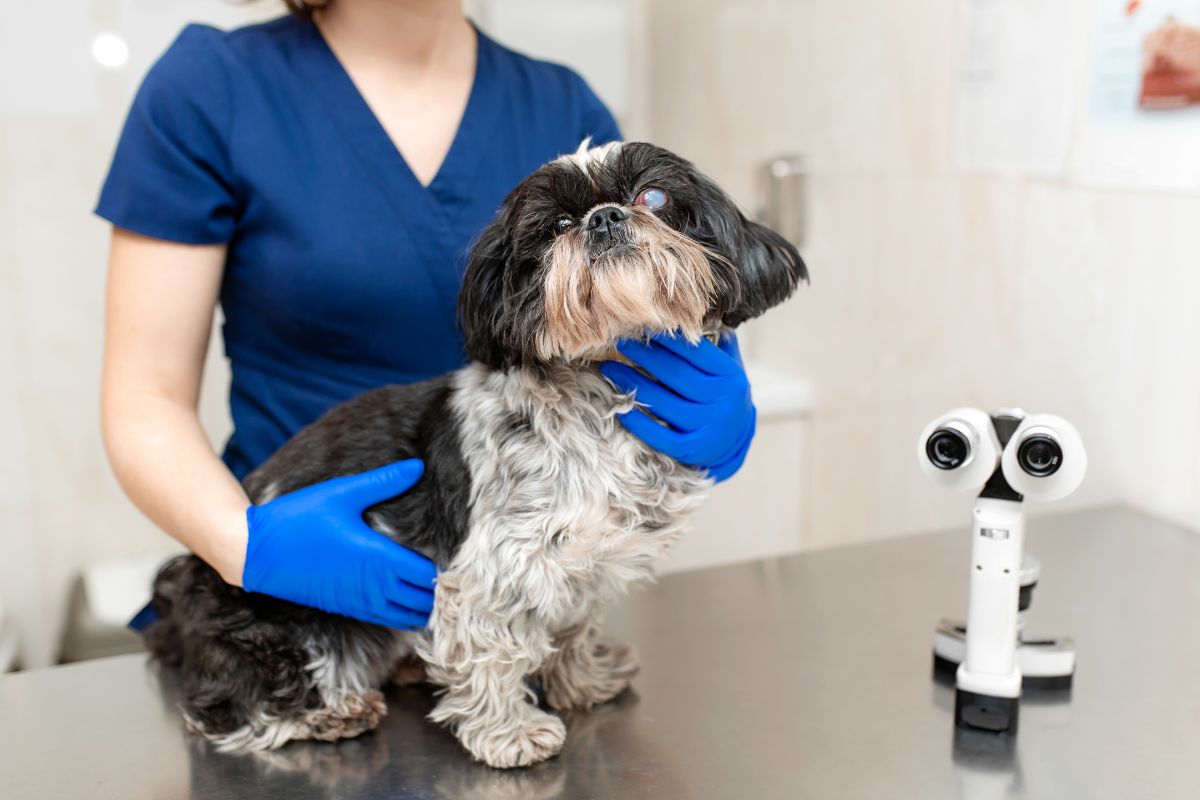What Does a Veterinary Ophthalmologist Do?
An animal ophthalmology specialist is a board-certified expert who diagnoses and treats disorders affecting the eyes and connected structures. Ophthalmologists are eye doctors. Any kind of animal can receive the services of a veterinary ophthalmologist.
Examining the eyes requires highly specialized equipment, such as the slit lamp biomicroscope, indirect ophthalmoscopy, tonometry, and various other modalities.
















Top Wild Animal Ophthalmology Books
Wild and Exotic Animal Ophthalmology: Volume 2: Mammals 1st ed. 2022 Edition
Publisher: Springer; 1st ed. 2022 edition (June 21, 2022)
Language: English
Print length: 599 pages
Availability: New, used
Format: Kindle edition, hardcover
Amazon.com Sales Rank: #271,108 in Books (See Top 100 in Books)
#32 in Histology (Books)
#45 in Veterinary Anatomy & Physiology
#97 in Zoology (Books)
Book Overview
The first textbook to present a practical and comprehensive method, Clinical Ophthalmology in Wild and Exotic Mammals, is a two-volume study. This second volume is the first publication among the two.
Before focusing on the various aspects of comparative anatomy and clinical management of ocular disease from one animal group to the next, a phylogenetic approach introduces the ecology and importance of vision across the full diversity of mammal species.
This two-volume work edit was by three of the most well-respected authorities in the field of exotic animal ophthalmology.
The non-mammalian species section (Volume 1: Invertebrates, Fishes, Amphibians, and Reptiles and Birds) and the mammalian species section differ from one another (Volume 2: Mammals).
A collection that veterinary ophthalmologists and other veterinary practitioners who work with wild and exotic animals need to have, Wild and Exotic Animal Ophthalmology, Volumes 1 and 2 is a two-volume set that covers the specialty.
Wild and Exotic Animal Ophthalmology: Volume 1: Invertebrates, Fishes, Amphibians, Reptiles, and Birds 1st ed. 2022 Edition
Publisher: Springer; 1st ed. 2022 edition (April 28, 2022)
Language: English
Print length: 716 pages
Availability: New, used
Format: Hardcover
Amazon.com Sales Rank: #283,182 in Books (See Top 100 in Books)
#35 in Histology (Books)
#52 in Veterinary Anatomy & Physiology
#104 in Zoology (Books)
Book Overview
When it comes to clinical ophthalmology in wild and exotic invertebrates, fishes, amphibians, reptiles, and birds, this is the first textbook to give an approach that is both practical and comprehensive.
This specific volume is the first of a two-volume study. There’s an introduction to the ecology of vision and its significance using a phylogenetic method before discussing the various aspects of comparative anatomy and clinical management of the ocular disease that vary from one species group to the next.
This is to prepare the reader for more in-depth discussions. The conceptual framework of evolutionary connections accomplishes this. The editing of this two-volume book on exotic animal ophthalmology was done by three of the most well-respected professionals in the area of ophthalmology for exotic animals.
The part on non-mammalian species (Volume 1: Invertebrates, Fishes, Amphibians, and Reptiles and Birds) and the section on mammalian species are separate from one another in this book (Volume 2: Mammals).
A two-volume set covering the specialty of ophthalmology in wild and exotic animals, Wild and Exotic Animal Ophthalmology, Volumes 1 and 2 is a collection of veterinary ophthalmologists and other veterinary practitioners who work with wild animals and exotic animals need to have in their libraries.
Small Animal Ophthalmic Atlas and Guide 1st Edition
Publisher: Wiley-Blackwell; 1st edition (April 10, 2015)
Language: English
Print length: 165 pages
Availability: New, used
Format: Kindle edition, paperback
Amazon.com Sales Rank: #1,233,653 in Books (See Top 100 in Books)
#15 in Veterinary Ophthalmology
#87 in Medical Atlases (Books)
#183 in Small Animal Medicine
Book Overview
This new textbook’s strength lies in its ingeniously designed, space-saving form and its helpful advice for eye diseases that are popular in the practice of veterinary medicine involving small animals.
General practitioners were shocked by how simple it was to recognize images and get information on the diagnosis and treatment of various eye conditions.
The Small Animal Ocular Atlas and Guide provides quick access to a picture-matching guide to common ophthalmic illnesses and critical topics relevant to diagnosing and managing these diseases.
As assistance in the diagnosis, the book’s first part contains a collection of images of ocular anomalies and condensed explanations of each. The book’s second half provides clear and concise answers to disease processes, diagnostic testing, and treatment options for each ailment.
The Small Animal Ophthalmic Atlas and Guide is a helpful tool that may be important in promptly formulating a diagnosis, diagnostic strategy, and treatment plan for small animal patients while maintaining high accuracy.
This text is the only resource that offers reference photos and information for managing the disease inside a single text, making it well suited for use in a fast-paced practice. Additionally, this text is the only resource to provide a single text.
For small animal general practitioners, veterinary interns, and veterinary students looking for a short yet comprehensive introduction to small animal ophthalmology, the Small Animal Ophthalmic Atlas and Guide is an easy-to-use resource that can greatly assist.
Within a single resource, it provides reference photos of ocular abnormalities and information for managing illness.
Provides carefully selected high-quality photos for comparison during diagnosis.
Provides concise explanations of diseases, with a primary focus on the most useful information for diagnosis and therapy.
It helps readers rapidly construct a diagnosis, diagnostic approach, and treatment plan while the animal is still in the exam room.
It also provides small animal practitioners, students, and interns with the most critical information on ophthalmology that you can find elsewhere. It’s straightforward to utilize in a clinical environment.
An examination of the article “A Useful and Convenient Tool for Everyday Consultations.” (Originally published in Vet Nurses Today on October 1, 2015)
According to the author, “This book will be useful for astute clinicians who can identify clinical ophthalmic abnormalities in patients but need a quick reference manual for guidance in diagnosing and treating those abnormalities.”
“This book will be useful for astute clinicians who can identify clinical ophthalmic abnormalities in patients who need a quick reference manual for guidance in diagnosing.”
“Astute doctors who can recognize the existence of clinical ocular anomalies in patients may find this book to be valuable.” (This article’s publication was online in the Journal of the American Veterinary Medical Association on September 15, 2015)
“This ocular atlas is beautiful, containing illustrations and explanations of illnesses and ailments. Including many photos ought to make identifying most frequent ocular diseases more doable.” (Doody 2016)
The Atlas and Guide are not for serving as a substitute surgical text, as the author makes clear in the introduction to the work, but rather as a rapid reference to supplement more comprehensive textbooks.
The essential part to remember about this book is that it does not absolve the practitioner of the responsibility of developing an acceptable protocol of good examination techniques and adequate equipment.
Instead, it will encourage the practitioner to learn more about ophthalmology and seek timely specialist ophthalmologist referrals for those patients who require such expertise.
Slatter's Fundamentals of Veterinary Ophthalmology 6th Edition
Publisher: Springer; 1st ed. 2022 edition (June 21, 2022)
Language: English
Print length: 584 pages
Availability: New, used, rent
Format: Kindle edition, hardcover
Amazon.com Sales Rank: #319,907 in Books (See Top 100 in Books)
#6 in Veterinary Ophthalmology
#166 in General (Books)
Book Overview
Slatter’s Fundamentals of Veterinary Ophthalmology, 6th Edition, will teach you how to detect, diagnose, and treat various common eye disorders. It will also enlighten you on how to manage these conditions.
The anatomy and function of the eye, the ophthalmic examination and diagnostic procedures, the medical and surgical therapy of ocular illness, and the management of visual crises are in detail with extensive revision.
Coverage for dogs, cats, horses, cattle, birds and exotic pets are clear. Coverage also includes unusual pets. In addition, over one thousand color images and graphics correctly portray ocular disorders seen in practice and demonstrate diagnostic and surgical procedures.
This reference is crucial to both the successful practice of veterinary medicine and the education of future veterinarians. Its editing was by three of the most respected specialists in the area of veterinary ophthalmology.
Clinical Tips boxes, such as “The Controversy Remains,” “Did You Know?”, “Look Again” and “Note” give the reader important practical tips and data.
The chapter on exotics now covers new species, such as birds and small animals, as well as others.
A patient with ocular illness requires evaluation, diagnosis, treatment, and ongoing monitoring.
This one-stop diagnosis reference to ocular illness in small and big animals, including dogs, cats, horses, livestock (cows, sheep, and goats), birds, and exotic pets, has information that is both practical and clinically oriented.
The following are new updates in the book:
- A chapter on ocular surgical methods includes tool and suture choice, patient placement, surgical preparation, and general techniques.
- These supplementary illustrations show various ophthalmic surgical procedures.
- Comprehensive coverage of ophthalmology for horses and animals
- Each chapter concludes with a list of suggested reading materials.
Histologic Basis of Ocular Disease in Animals 1st Edition, Kindle Edition
Publisher: Wiley-Blackwell; 1st edition (August 30, 2018)
Language: English
Print length: 447 pages
Availability: New, used
Format: Kindle edition, hardcover
Amazon.com Sales Rank: #3,344,672 in Kindle Store (See Top 100 in Kindle Store)
#72 in Veterinary Ophthalmology
#1,771 in Veterinary Medicine (Kindle Store)
Book Overview
Histologic Basis of Ocular Disease in Animals is a comprehensive reference covering the pathology of the eye in a range of animal species, including domestic animals, fish, birds, and laboratory animals. The book’s title is Histologic Basis of Ocular Disease in Animals.
The book is an excellent resource for ocular pathology since it contains over 1,200 high-quality photographs that exhibit the eye’s gross, subgross, and histological disorders. The selection of these images is with great care to accurately portray the ocular illnesses covered.
This book focuses on a disease that can affect the eye in several different species, and specific pathological reactions are notable when it is relevant.
This book contains introductory chapters on various topics, including the basic pathophysiology of ocular illness, the handling and processing of ocular tissues, and more. The next chapters focus on the clinical, gross, and histopathologic features of various eye disorders organized according to their etiology, tissue, and disease process.
The inclusion of relevant therapeutic viewpoints as well as copious references helps to broaden the scope of the information.
It allows you access to an extensive library of information on disorders and ailments affecting the eye and orbit in various animal species. It also includes fish, birds, research animals, and those kept in homes.
More than 1,200 high-quality photographs carefully selected to depict the ocular disorders in the discussion are in this book.
Places an emphasis, if appropriate, on specific pathological reactions. Veterinary ophthalmologists, veterinary pathologists, and residents working in either of these subspecialties will find the Histologic Basis of Ocular Disease in Animals to be an indispensable resource.
Essentials of Veterinary Ophthalmology 4th Edition
Publisher: Wiley-Blackwell; 4th edition (August 23, 2022)
Language: English
Print length: 912 pages
Availability: New, used
Format: Kindle edition, paperback
Amazon.com Sales Rank: #1,331,642 in Books (See Top 100 in Books)
#16 in Veterinary Ophthalmology
#530 in General (Books)
Book Overview
A reference that is easy to use and covers essential information on veterinary ophthalmology. This text offers readers a straightforward guide to the fundamentals of veterinary ophthalmology in an approachable format. It emphasizes the information that is most pertinent for use in clinical practice.
This book emphasizes canine ophthalmology but also covers the fundamentals of ophthalmology as it applies to feline, equine, farm animal, and exotic animal patients.
Review questions and the figures from the book are in a PowerPoint presentation on a companion website to facilitate better comprehension and retention of the knowledge by the reader.
The following are some examples of subjects discussed in the work:
- Foundations of ophthalmology include ophthalmic development and structure, the physiology of the eye and vision, as well as ocular pharmacology and treatments.
- Canine ophthalmology comprises the following specialties: canine orbit (disease and surgery), canine eyelids (disease and surgery), canine lacrimal apparatus (tear secretion and drainage), the canine cornea (diseases and surgery), and canine glaucoma.
- Ophthalmology of other species includes canine ophthalmology, horse ophthalmology, and ophthalmology of food and fiber animals.
- Ophthalmic and systemic diseases: a comparison of neuro-ophthalmology and the relationship between systemic illness and the eye
- Essentials of Veterinary Ophthalmology is a helpful resource for veterinary students and practitioners who want to expand their essential foundations of knowledge within their particular fields of study and academic programs.
Ophthalmology of Exotic Pets 1st Edition
Publisher: Springer; 1st ed. 2022 edition (June 21, 2022)
Language: English
Print length: 256 pages
Availability: New, used
Format: Kindle edition, paperback
Amazon.com Sales Rank: #1,079,145 in Books (See Top 100 in Books)
#12 in Veterinary Ophthalmology
#212 in Ophthalmology (Books)
#431 in Rabbit Pet Care
Book Overview
The diagnosis and treatment of eye illness in various exotic companion animal species, such as rabbits, rodents, reptiles, birds, amphibians, and fish, are available in this handy reference manual.
It specifies when it is okay to extrapolate from cat or dog eyes and when you require additional information to ensure that diagnosis and treatments are suitable for the individual species in question.
The author uses personal experience and a writing style that is approachable and grounded in reality to the specialized topic in discussion. The book has many ophthalmic photos, which depict anatomy in normal eyes and pathology in eyes with aberrant conditions.
It also has a separate chapter on the common ocular characteristics of exotic pets, detailing what you can learn through cross-species comparison. Another chapter presents a brief history of comparative ophthalmology. Both of these chapters are in this book.
Veterinary ophthalmologists and veterinary practitioners, and students interested in exotic pet species will find the Ophthalmology of Exotic Pets a helpful resource.
Key features include:
- Includes ungulates, rodents, reptiles, birds, amphibians, and fish in its scope of coverage.
- Provides elucidating direction for the treatment of each species
- Allows for extrapolations making from domestic animals to foreign species’ eyes
- Condensed style formatting is ideal for fast reference.
- Heavy use of color photos for illustrative purposes.
FAQs
Who is a Veterinary Ophthalmologist?
Certain diseases and injuries to the eye require the care of a veterinarian specializing in intensive veterinary ophthalmology training to provide the best outcome for your pet.
Certain illnesses and injuries, even though your general practitioner veterinarian can diagnose and treat many common eye ailments, require the attention of a specialized veterinarian in this area.
Cataracts, glaucoma, retinal detachments, and corneal ulcers are a few eye illnesses that can affect pets that you might be familiar with from your own experiences with an ophthalmologist.
Why Does My Pet Require the Services of a Veterinarian Specializing in Eye Care?
Even while a general practitioner veterinarian, similar to a primary care physician in human medicine, is capable of handling many aspects of your pet’s care, there are occasions when your pet requires the attention of a specialist.
Your pet may require the attention of a veterinary ophthalmologist if the condition it is experiencing is particularly complex or challenging.
You can be confident that a veterinarian who is caring and committed to ensuring that your pet receives the best medical care for its condition is also one who can tell when to refer your pet for more specialized treatment. This is something you can be sure of.
It is possible that, in some instances, your veterinarian will only need to consult with a specialist regarding the care of your pet. However, in other circumstances, it will be necessary for both you and your pet to see the specialist for additional diagnostic procedures and treatment options, including surgery.
What are Some of the Unique Conditions That an Animal Ophthalmologist May Treat?
Your general practitioner veterinarian can often resolve routine issues. However, the problems below typically require the assistance of an expert:
- Cataracts
- Corneal ulcer
- Entropion
- Glaucoma
- Uveitis
- Lens luxation
- Keratoconjunctivitis sicca (dry eye)
- Herpetic Keratitis in cats and other felines
- Cats suffering from Proliferative Keratoconjunctivitis
Will My Current Veterinarian Perform the Procedure?
As a comprehensive veterinary health care team member for your pet, your pet’s veterinary ophthalmologist will collaborate closely with your primary veterinarian. Your pet will continue to see the general practitioner veterinarian you have been seeing. Still, they will now include the advice and expertise of a veterinary ophthalmologist in their treatment plan.
For instance, if a veterinary ophthalmologist ultimately diagnoses diabetes in your pet due to an eye examination for cataracts, they will give that information to your general practitioner veterinarian, who will treat your pet’s diabetes.
This scenario will occur if the specialist performs an eye examination for cataracts on your pet. While managing your pet’s disease, your veterinarian may find it necessary to seek the different opinions of an ophthalmologist specializing in veterinary medicine.
What is the Educational Background and Clinical Experience for a Veterinary Ophthalmologist?
Before getting into a residency program, veterinary ophthalmologists, like most other types of specialists, must get their entire veterinary degree. On the other hand, the general course of their research deviates somewhat from that of some experts.
To become an ophthalmologist, they must complete at least one year of training in general veterinary medicine, after which they must apply for a residency program. Once accepted into the residency program, the total time commitment is three years.
The American College of Veterinary Ophthalmology (ACVO) will be the organization that administers the certification process. The American Society of Veterinary Ophthalmology established this educational institution in 1957 and has been operating continuously since then.
Students need to complete two parts of their residency: the first will certify them, and the second will provide them with a certificate that will allow them to work in their field.
The Advantages of Having a Veterinary Ophthalmologist for Your Pet
Veterinary ophthalmologists have sophisticated machinery that helps them treat various eye conditions. They have diagnostics including the following:
- The Schirmer tear test is for diagnosing dry eye diseases in your pet and determining the number of tears produced.
- Slit lamps are an instrument that examines the anterior chambers of your pet’s eyes.
- Fluorescein stain: a test for determining whether or not a corneal ulcer is present
What are Some Signs That My Cat May Have an Eye Problem?
There will be a lot of warning signals that your pet’s eye health is not up to standard. You will, fortunately, most likely be able to tell the difference between eyes that are healthy and eyes that are not healthy. However, you should check for the following symptoms:
- Avoiding light
- Bulging eyes
- Maintaining a closed-eye state
- Hazy or crimson appearance
- Discharge
- A surplus of tears
- Continuously rubbing their eyes or face.
These symptoms might indicate something as harmless as dry eyes or catastrophic as glaucoma or cataracts. It all depends on the underlying cause. Veterinary ophthalmologists receive extensive training to work with various animal species.
All types of domesticated animals, birds, and exotic animals are included in this coverage. These medical experts learn how to treat a wide variety of conditions, including but not limited to the following:
Cataracts
This is a disorder in which the third eyelid of a dog expands, giving the appearance of a red lump in the dog’s eye.
Herpes
Glaucoma is a condition that can affect a variety of breeds of dogs, including the Beagle, the Cocker Spaniel, and the Basset Hound.
Dry Eyes
Pannus is a disease in which a lesion forms and progressively covers the cornea; this disorder is common in elderly German Shepherds. Pannus is treatable with medication.
Antibiotics and eye drops are the most common forms of treatment for eye diseases; however, if the condition is severe or has progressed further, the animal will need to undergo surgery. Some of these conditions pass on from one’s parents, while others are secondary complications of other diseases, such as diabetes or cancer.
Veterinary ophthalmologists are another resource for determining whether or not a potential canine breeding parent has any eye problems. It is up to the breeders to do these inspections to ensure that the puppies are born healthy and do not develop any of these problems in the future.
That’s a Wrap
Like most other veterinary professionals, Ophthalmologists need to maintain their competence through ongoing education through seminars, classes, and other similar activities. Without it, their knowledge and abilities will deteriorate and become less relevant.
On the ACVO website, you will find an exhaustive list of presently practicing experts, inactive members, retired members, and specialists who do not practice anymore. You may use this list to verify the authenticity of a specialist. This is a useful method for determining experts’ location and the length of time they have been in practice.
You should compile a list of queries before making an appointment with a veterinary ophthalmologist. You might want to investigate the following questions, among others:
- Will my pet’s vision get more impaired due to this particular condition?
- Is there a surefire treatment for it?
- What other kinds of treatments are there to choose from?
- Is it possible that my breeding animal might pass on this condition?
- If I attempt this treatment, what is the likelihood of recovery? May there be a chance that this circumstance will occur again?
Maintain a high level of care for your four-legged friend’s eyes at all times. When you do this, you may detect eye diseases early, before too much harm happens, making it a preventative measure.










